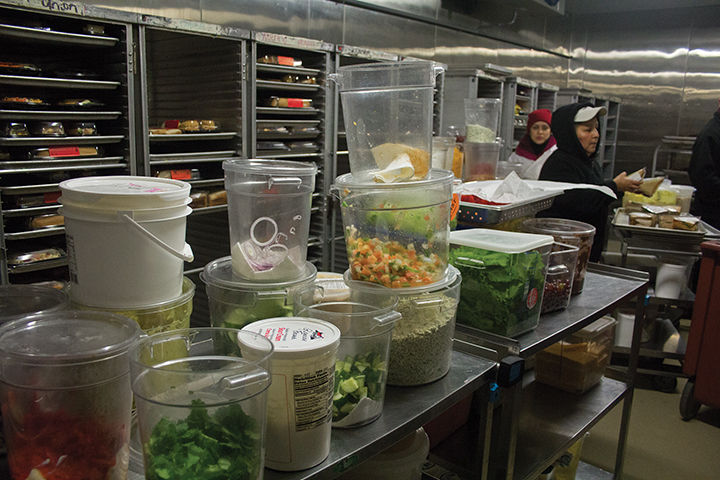
The sandwich shop in 251 North makes nearly 1,000 sandwiches by 8 a.m. every morning.
By 8 a.m. every morning, the workers at the Maryland Sandwich Factory have already made roughly 1,000 different sandwiches and salads to distribute to the campus community.
Starting at 5 a.m., 19 men and women dash between two freezer rooms while wheeling carts of meat, veggies and premade sandwiches seven days a week in the 251 North workspace, which resembles a kitchen more than a factory.
“We became better streamlined to get the product done on a daily basis over here compared to the South Campus cold room, which was outdated,” said Rob Fahey, 251 North general manager.
The fast-moving operation is how Dining Services manages to provide those prepackaged sandwiches to 16 shops across the campus, Fahey said.
Workers arrive early to start slicing the deli meat and fresh produce. As each item is made, the employees organize carts of food to easily load into trucks by 8 a.m. so the items can arrive on campus shelves by 11 a.m., he said.
Despite the strict sandwich-making deadline and hectic pace, Sonya Effel, who has worked at the Sandwich Factory for four years, said the process soon began running smoothly.
“It is a little crazy,” she said. “But we are used to working under pressure, so we can do just fine.”
Effel said the friendly camaraderie and teamwork among her coworkers helps get the job done. But getting used to working in the 38-degree storing rooms is one of the most challenging things for them to adjust to. To stay warm, the sandwich-makers wear multiple layers, including sweatshirts, hats and aprons while working.
While the Sandwich Factory has existed for about 30 years, operations greatly improved four years ago when they moved production from the cramped, minimalistic South Campus Dining Hall to the larger kitchen in 251 North, said John Gray, the senior executive chef.
The area used now features additional freezer space and new cooking instruments for efficient production, Gray said.
“Where before it used to be just a sandwich factory, now it’s like a commissary,” he said.
The extra space means they can carry a larger variety of fresh products while expanding production. With more ingredients and space to work with, Fahey and the team got creative and made new types of sandwiches, he said.
“I live in Baltimore, and up the street from me is a chicken and waffles place,” Fahey said. “I was like, ‘I think kids will eat that!’”
The sandwich, a fried chicken thigh between two waffles, is one of the operation’s newest creations and has received moderate success, he said.
A line of microwavable pasta, Chef Rob’s Pastas, came from a similar type of inspiration. After seeing a pasta picture from a calendar in a campus convenience store, Fahey realized he could easily recreate the dish.
“I thought, ‘Oh! We could do that!” he said. “We have a pasta cooker, and we could just add sauce and meatballs or vegetables.’”
Fahey also applies the same attitude when looking at trade show or convention magazines, he said, as well as during his trips to the grocery store Wegmans, which he said inspired various wraps and sandwiches.
Each new item is typically invented during the summers, when Fahey and other chefs try out new recipes. But not every item is a runaway success, Fahey said, citing a short-lived Asian fried beef salad design from a few years ago.
“After we breaded it and then deep-fried it, it sat on the salad,” he said. “It would lose its appeal.”
Out of all the new items, however, Fahey said his favorite is still a timeless classic — the club sandwich.



